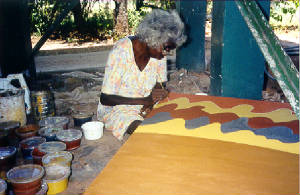|

I had come to Warmun to conduct anthropological
research. But more than anything else I have experienced my time in the field as a personal process of learning. I
started as an outsider to Gija culture, often felt terribly white, went through doubts and uncertainties, but while time evolved
I mingled in more. When after four months I took the plane to Sydney and found myself at a corner of Eddy Avenue, shaking
with the sight of the traffic passing by, I realized how profound living in Warmun had been.
I was interested in how art was used to communicate knowledge about identity
and spend much time at the local art centre, where I also volunteered. I prepared canvas boards for the artists, wrapped up
the paintings that were sold, crushed up ochred they used for their paint, and handed out tea and water. Gradually I learned
the social codes needed for interaction. I learned to communicate differently, less direct and abstract, and mixed in some
Gija words that I had picked up, which usually caused hilarious laughter. I also noticed the importance of body contact: holding
hands, a quick caress, and sometimes a hug. It became common to embrace the older female painters when we met in the morning.
Some of the artists liked to hold my hand when I talked with them. Joking was an important part of our relationship.

|
| My 'mother' Betty Carrington |
My position amongst the Gija was one of a ‘novice’. ‘You must learn,’
is what people often told me, treating me in the same way as young Gija people. It was out of the question that I could just
ask anything, and they expected from me that I was patient. I resigned myself to this, and spent a lot of time just sitting
with the artists and waiting until they told me something. There were certain things they liked to talk with me about, and
these directed me in my research. They did like to talk with me about their country,
its sacredness, their own history in it, as well as that of their ancestors. Some of them took me to their country, which
I felt as a great privilege and which was also essential to understand their paintings. Real
acceptance came when I was given a skin name, Nambin, which meant
that my totem was that of the black-headed snake and that I had responsibilities towards the people I was now related to.
Betty Carrington, a wonderful artist with whom I often sat down, became my mother, which strengthened the tie I had already
felt with her.


|

